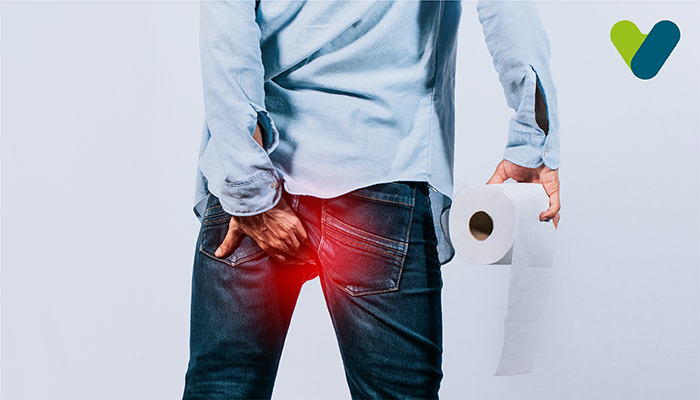Shweta's father suffers from piles. Many doctors have tried to help him but to no avail. The piles always come back. To help him and provide a solution for his problem, Shweta starts researching piles and it's treatments. She finds a lot of valuable information. Here is the information that she discovers:
What are piles?
Piles are also known as hemorrhoids, are swollen and enlarged that form inside and outside the anus and rectum. The type of hemorrhoids depends on where the swollen vein develops. If the hemorrhoids develop inside the rectum or under the skin around the anus. Piles can have a range of sizes.About 50 percent of adults experience pile symptoms by the age of 50. Common symptoms of piles include rectal bleeding, itching, and pain. The cause of piles is straining which puts pressure on the belly or lower extremities and causes veins in the anus or rectum to become swollen and inflamed. These causes include Pelvic pressure from weight gain especially because of pregnancy, constipation and weight lifting
Piles can be prevented by keeping stools soft. Eating fiber-rich foods, avoiding over-straining, doing physical activities, maintaining a healthy body weight, drinking enough water, and going to the toilet when needed are ways of preventing piles.
Piles are classified into 4 grades. Grade 1 are small inflammations inside the anus's lining. Grade 2 is larger than grade 1 but remains inside the anus. Grade 3 are prolapsed hemorrhoids that appear outside the anus. Grade 4 is large and remains outside the anus. These piles need treatment.
Piles don’t often cause pain. Sometimes, External piles can become painful if a blood clot develops. This is known as a thrombosed hemorrhoid. The thrombosed external piles require immediate medical attention.
Most piles go away on their own. Treatment focuses on relieving symptoms.
Treatment of piles
1. Home remedies
Mild pain, swelling, and inflation of piles can be treated with home remedies. These home remedies are:
-
- Consuming high-fiber foods: Eating high-fiber foods like fruits, vegetables, and whole grains helps in softening stools and increasing the bulk of stools, which helps in avoiding straining.
- Topical treatments: Over-the-counter hemorrhoid creams or suppository containing hydrocortisone, or using witch hazel or numbing agent pads are common topical treatments used for piles.
- Warm bath: Soaking in a warm bath or sitz bath for 10 to 15 minutes, two to three times a day helps in relieving pain.
- Ice pack and cold compresses: Applying ice packs and cold compresses to the affected area can help calm the swelling.
- Oral pain relievers: Acetaminophen (Tylenol, others), aspirin, or ibuprofen (Advil, Motrin IB, others) temporarily to help in relieving discomfort associated with piles.
2. Medications
Your doctor might suggest creams, ointments, suppositories, or pads for the discomfort caused by piles. These products contain pain-relieving ingredients like hydrocortisone, witch hazel, or lidocaine. Unless directed by a doctor do not use an over-the-counter steroid cream for more than a week as it can lead to thinning of the skin.
Corticosteroids can help in reducing pain and inflammation. Laxatives may be prescribed if piles are caused because of constipation. This can help the patient pass stool more easily and reduce pressure on the lower colon.
-
Surgical options
In cases of persistent bleeding or painful piles, surgery is available. The minimally invasive procedures like rubber band ligation, sclerotherapy, and coagulation can easily be done in a doctor’s office or outpatient setting.
- Rubber band ligation: This procedure involves placing one or two tiny rubber bands around the base of internal hemorrhoids to cut off its blood circulation. Rubber band ligation is effective in 75% of cases and is the most common procedure for internal hemorrhoids. This causes internal hemorrhoids to wither and fall off in a week. Rubber band ligation can be uncomfortable and cause bleeding after two or four days of the procedure, but it is rarely severe.
- Injection (sclerotherapy): A chemical solution is injected into the piles to shrink it. This procedure is less effective than rubber band litigation and it causes little to no pain.
- Coagulation (infrared, laser, or bipolar): A laser, infrared light, or heat is used as a coagulation technique to cause small, bleeding, and internal hemorrhoids to harden and then shrivel. A little discomfort is common and a few side effects are experienced with coagulation.
- Hemorrhoid removal (hemorrhoidectomy): Excessive tissue that causes bleeding is surgically removed. This surgery is effective in 95 % of cases and is used for treating both internal and external piles. Various techniques can be used for this surgery and it can be done with a combination of local anesthesia and sedation, spinal anesthesia, or general anesthesia.
This is the most effective way to treat severe or recurring piles but is usually reserved for those who do not respond to other treatments. The complications involved are urinary tract infections and difficulty passing stools.
- Hemorrhoid Stapling: This is a procedure that blocks blood flow to hemorrhoidal tissue. Internal piles are usually treated with this procedure. It is less painful than hemorrhoidectomy. However, stapling has an increased risk of recurrence and rectal prolapse, in which a part of the rectum comes out from the anus. Other complications include urinary retention, pain, bleeding, and in rare circumstances, sepsis.
Conclusion
Piles are painful and unpleasant but they are also easily treatable and preventable. In most cases, simple home remedies can alleviate the symptoms and piles can get better without treatment. However, in some cases, medicines and surgery might be needed.Piles also do not usually pose any ongoing threat to health but they can get worse over time, that is why doctors suggest treatment as quickly as possible.


